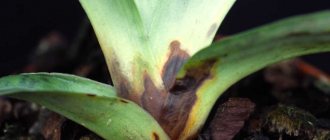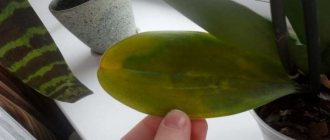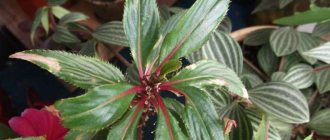We all make mistakes in life sometimes.
But the main thing is that our mistakes do not cost someone’s life, for example, an orchid.
Errors in caring for home orchids occur mainly due to ignorance.
Most often among novice orchid growers. Seeing yellowing or flabby leaves, they panic and begin to look for information about the terrible disease. And strangely enough, they find it!
As a result, the poor flower either immediately flies into the trash can (with a diagnosis of a “mega dangerous virus”), or is healed to death and only then flies into the trash bin. An unenviable fate for a houseplant, isn't it?
If you notice any symptoms of illness, this does not mean that the orchid necessarily has an infectious disease.
These may be, and most often are, simply the consequences of improper maintenance and care of the orchid.
Therefore, in order not to get ahead of yourself in your conclusions about the presence of infection, first familiarize yourself with possible errors in home orchid culture and their consequences.
Based on the symptoms, you can determine the cause of the illness and correct the conditions of detention. So, the symptoms:
What causes burns?
Burns may appear due to a change in place of residence, for example, when their store moves to your home or changes location within an apartment. In this case, the plant, not accustomed to intense lighting, figuratively chokes on the light and gets burned. In the spring-summer period, with increasing sun activity, the orchid can also get burned, and even a short stay of the plant in direct sunlight is enough. Also, spots can appear due to the so-called heat stroke, with poor air ventilation. To prevent burns on orchid leaves, it is necessary to protect them from the midday sun, monitor whether the plant is overheating, since hot leaves are easily damaged by sunlight, provide a flow of fresh air and a sufficient amount of water. It should be remembered that phalaenopsis, miltonia, cumbria and lady's slippers with delicate leaves easily overheat, while cattleyas, dendrobiums, oncidiums and cymbidiums need bright sunlight to set flower stalks.
Heat
The most comfortable temperature for orchids is considered to be 18-25 degrees, but in summer it sometimes rises to 35 degrees or more. If this increase is short-term, then the plants can tolerate it, but prolonged heat can weaken the immunity of orchids, which can lead to stunted growth or the development of diseases.
To help plants survive hot days, you need to move them from window sills and place them at a short distance from the window to provide diffused lighting. In order for orchids to feel comfortable in the summer, you need to monitor the temperature and humidity in the room. Using an air conditioner will have a good effect, but only on condition that the plant is located away from the flow of cold air.
In summer, you need to provide more frequent watering than at other times of the year, since moisture evaporates quickly. Do not let the soil become completely dry and leave the orchid there for several days. Watering should be done with soft water. It is necessary to maintain air humidity by periodically spraying the substrate or placing trays of water next to the pots.
The money tree pleases with lush flowering: my secret is in caring for the leaves
Women's jeans: before you buy them, you need to pay attention to one detail
“We are still friends”: Derevianko commented on the breakup with his wife
What does sunburn look like on an orchid?
As a rule, the leaves or neck of the orchid are damaged. Burns appear as various spots. There are two types.
- Dry spots of light color with or without an outline.
- Heterogeneous weeping spots.
I’ll note right away that the first option is better for you, such spots rarely grow and spread, and if you shade the orchid, then the orchid and you will get off with a slight fright - the plant will simply dry out the damaged leaf over time.
Dry sunburn on a dendrobium leaf
With wet spots it is a little more difficult, a bacterial infection can develop there and the spots will begin to grow, eating the plant.
weeping sunburn spot
Bacterial diseases
Diseases of this type occur when exposed to bacteria that cause rotting. They lead to the formation of dark spots on the flower, as well as to the fact that the leaves gradually turn black and die. If the plant is not treated in a timely manner, it gradually dies.
Having discovered dark spots on the leaves, you need to cut off the affected areas with a sharp, disinfected knife, and then treat the sections with crushed activated carbon or a product containing copper. To prevent the spread of the disease, copper sulfate is treated every month.
If there is little snow, there will be no harvest: December 16 is Ivan the Silent Day
Lost weight: what Sofia Tarasova sacrificed for the sake of “VIA Gra” (new photos)
"Dad is offended." Agata Muceniece about her relationship with Priluchny after the divorce
What to do if an orchid gets burned
After we remove the orchid from the sun, take a felt-tip pen or marker and draw lines along the boundaries of the spots. This way we can quickly notice and respond to their growth. If the damage does not spread, then everything will be fine and a little later it will be possible to cut the leaf to living tissue. Otherwise, I sprinkle the stain on the leaf with a crushed tablet of any antibiotic from a human pharmacy or baneocin. These measures prevent the development of a bacterial infection. If the spots are located on the neck, then our actions are the same as for rot, cut it out and wait for the baby.
This is written in detail in the articles:
How to save a phalaenopsis without a growing point and get a baby from it
How to recognize that the neck of a phalaenopsis is rotting and what to do about it?
Flowering problems
Indoor orchids are very capricious plants. They react very sharply to any changes in care or conditions of detention. Often problems begin almost immediately after purchasing the plant. If flowering does not begin on time, there may be the following reasons:
- watering errors;
- insufficient lighting level;
- sudden change in air temperature;
- lack of quiet time.
The most common mistake in growing orchids is not getting enough light. This leads not only to a lack of flowering, but also to the withering of the plant itself. For most species, being in partial shade ends in the death of the flower.
This can be recognized by the appearance of the leaves. They become a bright green shade. If the foliage turns yellow, it means there was too much ultraviolet radiation. Depending on the shade, the flower needs to be moved to a more illuminated place or to partial shade.
Another fairly common reason for the lack of buds is diseases of the root system. It is not at all easy to understand this from the appearance of the flower. Some plants continue to bloom even with diseased roots. If there are no problems with lighting, but there are no buds on the orchid, then you need to check the root system. Due to too much watering, it begins to rot. Then the solution to the problem will be transplantation with the removal of damaged roots.
Smooth and fresh skin: dermaplaning, or why a woman needs to shave her face
A Brazilian travels 36 km by bike every day to take his loved one home.
A student at the Vietnam Police Academy shared how she takes care of her facial skin.
Another reason for the lack of flowering is a change in habitat. If the plant was purchased recently and brought home, the buds usually begin to wither and fall off. It is imperative to choose the right place to place the flower in order to create optimal conditions for it.
Sometimes the buds wither due to pests. Mealyworms suck the juice from the petals and cause them to quickly die. As a result, dark spots form on the flowers.
Prevention of recurrent illnesses
Plants need fresh air; it is worth ventilating the room, but without drafts . To prevent brown rot, you need to spray the orchid with copper sulfate once a month. The best prevention of fungi is to strictly follow the care instructions and observe all the necessary living conditions for plants.
To prevent root rot, you need to use high-quality soil, and when watering, use drugs that increase the plant’s immunity. After watering, water should be removed from the leaf axils and pseudobulb cores with a cotton swab or napkin. To prevent the plant from getting powdery mildew again, it can be sprayed with Fitosporin.
Complete loss of roots
You can save an orchid without roots if you move the flower to a home greenhouse or place it in an aquatic environment. Sometimes, to maintain the elasticity of the leaves, rub them with a solution of sugar or honey (1 tsp per 1 liter of water)
Losing all the parts
Reviving a flower without roots and leaves will be difficult. First, you will need to grow the roots (in water, in a greenhouse, using fertilizers or using a rooting agent). Then the plant is planted in a greenhouse with a very humid and warm climate (humidity 60%), choosing suitable soil.
Opal greens
When the leaves of an orchid fall off, you need to remove the remaining damaged parts with scissors, process the cuts, and if there are healthy roots, the plant can survive. It needs to be disconnected from other indoor plants, moved to a bright and warm room, additionally fertilized and properly cared for.
Pimples and tubercles on leaves
Sometimes the leaves become swollen and have bumps and bumps. This could be a fungus or a consequence of uninvited guests settling on the orchid.
— Small tubercles on the leaves can be mycelium or nests of pests;
— Volumetric swellings on apparently healthy leaves are swelling when the orchid does not have time to process all the moisture it absorbs from the ground. It is necessary to reduce watering, dry the substrate and give the plant time to recover.
Photo: podomu.info
Should I take vitamin E supplements?
If a person eats more or less normally, he needs 4 years of extreme diet to use up all the vitamin E reserves in the liver. Therefore, tocopherol deficiency is rare. It usually appears if a person has impaired lipid absorption.
“Without fats, normal absorption of vitamin E is impossible, so it is important to include oils in your daily diet,” explains Nadezhda Nabatnikova. — Wheat germ oil, sunflower oil, safflower oil and soybean oil are rich in vitamin E. Nuts such as almonds and peanuts are also suitable sources.”
Only your doctor can decide whether you should take vitamin E supplements. If you self-medicate and drink “for health”, you can get hypervitaminosis. It is manifested by nausea, vomiting, weakness, headache and blurred vision. Particularly persistent ones lead themselves to disorders of the blood coagulation system.
Phytophotodermatosis
Such reactions are also known as plant-induced phytophotodermatitis. This is a group of skin reactions that occur by a non-immune mechanism after skin contact with plants containing phototoxic substances and exposure to ultraviolet radiation.
The most common compounds present in plants that cause phytophotodermatitis are furanocoumarins (psolarens, angelicins). They are present among others in the celery family (Apiaceae), which includes, for example, fennel, parsley, celery, lovage, Sosnowski's hogweed. And also in the Rutaceae family, which includes citrus fruits, rue and bergamot.
These reactions often occur in people who sunbathe in meadows, mow grass, and in children playing in the garden. The typical clinical picture is blisters on an erythematous substrate, well demarcated, affecting exposed skin areas (face, upper and lower extremities), with characteristic hyperpigmentation.











